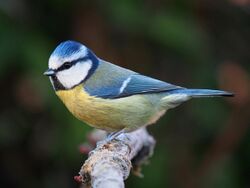Biology:Cyanistes
| Cyanistes | |
|---|---|

| |
| Eurasian blue tit (Cyanistes caeruleus) | |
| Scientific classification | |
| Domain: | Eukaryota |
| Kingdom: | Animalia |
| Phylum: | Chordata |
| Class: | Aves |
| Order: | Passeriformes |
| Family: | Paridae |
| Genus: | Cyanistes Kaup, 1829 |
| Type species | |
| Parus caeruleus Linnaeus, 1758
| |
| Species | |
|
C. caeruleus | |
Cyanistes is a genus of birds in the tit family Paridae. The genus was at one time considered as a subgenus of Parus. In 2005 an article describing a molecular phylogenetic study that had examined mitochondrial DNA sequences from members of the tit family, proposed that a number of subgenera including Cyanistes be elevated to genus status.[1] This proposal was accepted by the International Ornithologists' Union[2] and the British Ornithologists' Union.[3]
Species
The genus contains three species:[2]
| Image | Scientific name | Common Name | Distribution |
|---|---|---|---|
 |
Cyanistes caeruleus | Eurasian blue tit | Europe |
 |
Cyanistes teneriffae | African blue tit | northern Africa and the Canary Islands. |
 |
Cyanistes cyanus | Azure tit | Russia and Central Asia and northwest China, Manchuria and Pakistan. |
The name Cyanistes was introduced for a subgenus by the German naturalist Jakob Kaup in 1829.[4] The word comes from the classical Greek kuanos meaning dark-blue.[5] The type species was designated as the Eurasian blue tit by George Gray in 1842.[6][7]
References
- ↑ Gill, F.B.; Slikas, B.; Sheldon, F.H. (2005). "Phylogeny of titmice (Paridae): II. Species relationships based on sequences of the mitochondrial cytochrome-b gene". Auk 122: 121–143. doi:10.1642/0004-8038(2005)122[0121:POTPIS2.0.CO;2].
- ↑ 2.0 2.1 Gill, Frank; Donsker, David, eds. "Waxwings and their allies, tits & penduline tits". World Bird List Version 6.1. International Ornithologists' Union. http://www.worldbirdnames.org/bow/waxwings/. Retrieved 25 March 2016.
- ↑ Sangster, G.; Collinson, J.M.; Helbig, A.J.; Knox, A.J.; Parkin, D.T. (2005). "Taxonomic recommendations for British birds: third report". Ibis 147 (4): 821–826. doi:10.1111/j.1474-919x.2005.00483.x.
- ↑ Kaup, Jakob (1829) (in German). Skizzirte Entwickelungs-Geschichte und natürliches System der europäischen Thierwelt : Erster Theil welcher die Vogelsäugethiere und Vögel nebst Andeutung der Entstehung der letzteren aus Amphibien enthält. c. 1. Darmstadt, Leipzig: Carl Wilhelm Leske. p. 99. https://www.biodiversitylibrary.org/page/41576522.
- ↑ Jobling, James A. (2010). The Helm Dictionary of Scientific Bird Names. London: Christopher Helm. p. 126. ISBN 978-1-4081-2501-4. https://archive.org/details/Helm_Dictionary_of_Scientific_Bird_Names_by_James_A._Jobling.
- ↑ Gray, George Robert (1842). Appendix to a List of the Genera of Birds (2nd ed.). London: R. and J.E. Taylor. p. 8. https://www.biodiversitylibrary.org/page/14050355.
- ↑ The Howard & Moore Complete Checklist of the Birds of the World. 2: Passerines (4th ed.). Eastbourne, UK: Aves Press. 2014. p. 430. ISBN 978-0-9568611-2-2.
Wikidata ☰ Q133565 entry
 |

